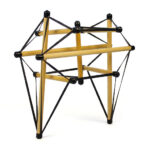QSM3 vs NUCCA Chiropractic: A Gentle Approach to Spinal Health
Patients often ask, “What’s the difference between the two Upper Cervical Methods, Quantum Spinal Mechanics 3 (QSM3) and NUCCA (National Upper Cervical Chiropractic Association)? The answer is both historical and technical and we will briefly explore both in this article.
 Upper Cervical Chiropractic is a general term to describe the 8-10 Upper Cervical methods that focus specifically on the alignment of the upper neck and its relationship to posture, the nervous system and human health. The one commonality that all of the Upper Cervical techniques share is their specificity, gentle nature and deep understanding of the immense importance of maintaining proper alignment of the Upper Cervical spine.
Upper Cervical Chiropractic is a general term to describe the 8-10 Upper Cervical methods that focus specifically on the alignment of the upper neck and its relationship to posture, the nervous system and human health. The one commonality that all of the Upper Cervical techniques share is their specificity, gentle nature and deep understanding of the immense importance of maintaining proper alignment of the Upper Cervical spine.
The Upper Cervical spine protects the brainstem, the area where the brain meets the spinal cord. This area is one of the highest neurological control centers of the body and maintaining alignment of the Upper Cervical spine has profound health benefits for the patient.
Upper Cervical adjusting started in Chiropractic’s early years with BJ Palmer’s “Hole-in-One” technique. Throughout the decades, Chiropractors expanded their understanding of the biomechanics of the spine and various techniques were developed.
Typically, the techniques varied in their method of analysis and the actual delivery of the spinal adjustment. Some Upper Cervical techniques have been administered by hand and others with gentle instruments.
Table of Contents
NUCCA Chiropractic: Gentle and Precise Care for the Upper Cervical Spine
NUCCA was developed by Dr. Ralph Gregory in 1967. Dr. Gregory was a Chiropractic innovator who built upon the available knowledge and developed various systems to deliver a very specific adjustment to the upper cervical spine that would influence the entire spinal column. These innovations included new methods of taking x-rays, analyzing x-rays and adjusting. The NUCCA analysis is one of the most detailed x-ray analyses in Chiropractic. The x-ray analysis focuses on the relationship of the Skull, the Atlas vertebra (C1) and the cervical spine in a 3-dimensional model. This allows the practitioner to develop an individualized adjustment vector or angle specific to the patient. NUCCA has gained a stellar reputation for highly accurate chiropractic work that has helped thousands and thousands of people suffer less.
QSM3 Chiropractic: A Precise Full-Body Balancing Technique
Like all branches of healthcare, our science and understanding progresses. Dr. Russell Friedman who currently practices in Alpharetta, GA is board-certified in three Upper Cervical techniques, QSM3, NUCCA and Orthospinology.
Around 2008, Dr. Friedman started exploring new biomechanical concepts such as tensegrity and the role the myofascial system plays in spinal alignment. He built upon his extensive knowledge of NUCCA and Orthospinology and developed new methods of “releasing” structural tension to correct spinal mechanics.
He began evaluating the relationship of the legs and pelvis to cervical alignment. He postulated that neck misalignments are typically ‘compensations’ for structural misalignments of the lower extremity, pelvis and spine. The “righting reflex” is a neurological mechanism that will tilt the head to maintain visual balance. The righting reflex can create alignment issues which in turn put stress on the spine and cervical nerves.
The analysis started to shift away from solely measuring cervical misalignment and instead evaluating the “whole body” 3-dimensionally. This led to the clinical application of the principle of tensegrity.
The human body withstands 2000 pounds of consistent and constant gravitational pressure and requires a supportive internal spring-like tension to help maintain its structure. The traditional chiropractic model is that the spine and its vertebrae are stacked on top of each other bearing compressive force.
Tensegrity provides a fresh look at the human biostructure and our entire posture from the lower extremity to the skull as one contiguous bio-tensegral unit supporting balance through the nervous system. Imagine an expanding balloon protecting the fascial and osseous system as it breaks down globally. Tensegrity- the current jargon for Tone – is key in helping us restore and release the physical, and energetic stresses that challenge our ability to remain upright, functional, and structurally balanced. The result is one system in Tensegral Tone.
(Citation: Dr. Russell Friedman, https://qsm3.com/qsm3-tensegrity/)
 The human body is a “tension system” that once injured starts to break down or collapse. This may be visualized in the model depicted in the attached image of sticks and rubberbands.. The tension of the system is providing its structure. Tension creates structural integrity hence “tensegrity”.
The human body is a “tension system” that once injured starts to break down or collapse. This may be visualized in the model depicted in the attached image of sticks and rubberbands.. The tension of the system is providing its structure. Tension creates structural integrity hence “tensegrity”.
 A can of soda is an example of a structure that has tensegrity. You can push down as hard as you can on a can of soda and it will not collapse due to its structural integrity. However, put a little twist in the can or a dent and the whole will begin to collapse.
A can of soda is an example of a structure that has tensegrity. You can push down as hard as you can on a can of soda and it will not collapse due to its structural integrity. However, put a little twist in the can or a dent and the whole will begin to collapse.
In a similar fashion, trauma to the spine and its surrounding structures can lead to a “structural collapse” resulting in spinal pain, neurological symptoms and eventually degenerative changes (i.e, osteoarrthritis, disc herniations and stenosis).
The understanding of tensegrity as it applies to the spine and delivering care based on this principle is one of the fundamental differences between NUCCA and QSM3. NUCCA visualizes that “bone(s) are out of place” and through a precise application of force; their alignment can be restored.
QSM3 visualizes the spine as a 3-dimensional system that is “breaking-down” under the forces of trauma and gravity. Through various “release” sequences applied to the cervical spine and surrounding fascia, the compressing system can be released to a more upright and stable position. In turn, this allows for better neurological function and affords the body the ability to heal.
The body utilizes a majority of its energy to maintain itself upright against gravity. Deviations from balance will require a higher energy expenditure. Accidents and injuries throughout our lifetime damage structures (Fascia, tendons and ligaments) that surround the spine leads to changes in posture and structural integrity.
Overtime, these changes lead to a gradual collapse of the body mechanics which require more energy for the body to maintain itself upright in the gravitational field. Altered biomechanics lead to abnormal movement patterns, progressive breakdown of joint structures (i.e., discs, ligaments and bone) and eventually symptoms will appear. If the altered biomechanics aren’t corrected, irreversible damage in the form of osteoarthritis, disc degeneration and stenosis will begin to appear on imaging.
Dr. Michael Thomas best summarizes this core concept of Tensegrity:
The whole body consequences of tensegrity led Dr. Friedman to look at what happens when tensegrity breaks down and results in asymmetrical compressive forces that distort the body posture. This was a significant breakthrough. Chiropractic and Upper Cervical Chiropractors alike use a downward corrective force. Dr. Friedman recognized on all full spine views a commonality of bowing and spiraling. The new perspective initiated examination of the mechanics and consequences of decompression. Removing compressive forces that held the body in a downward spiral (curvilinear)and restoring it to a linear misalignment which could then be corrected was now understood to be essential.
Clinically, the use of the “Grid” (a large 2D Cartesian grid poster) facilitates visual measurement of the low shoulder and the side of body compression. QSM3 has now evolved to understand how and when to best release the compression. Working synergistically and releasing structures towards the vertical allows the tensegral structure to release most efficiently. Just as a compressed spring would be best released (and with least non-harmonic resonance) towards neutral zero (the gravity line). (Citation:https://qsm3.com/qsm%c2%b3-history-of-upper-cervical-chiropractic-so-far/)
Healing Benefits of QSM3 Chiropractic
Quantum Spinal Mechanics or QSM3 chiropractic is a precise and corrective form of body balancing chiropractic. This technique specializes in working with the body’s central balancing mechanisms, maintaining a person’s ability to function efficiently in a gravity environment.
QSM3 chiropractic aims to restore joint symmetry, muscle balance, proper blood and oxygen flow to the brain, and cerebrospinal fluid flow. This may lead to better healing, circulation, oxygenation, improved sleep, mood, immune function, and digestion. Patients often report relief from chronic pain conditions and an overall improvement in quality of life.
Patients typically experience long-term pain relief without the need for snapping or cracking the neck. A wide range of patients, including those suffering from migraines, vertigo, fibromyalgia, neuropathic pain, disc herniations and chronic fatigue, have reported relief following QSM3 care.
Practitioners of QSM3 chiropractic conduct a thorough biomechanical and neurological assessment in the initial treatment session, establishing individual treatment goals for patients and crafting individualized care recommendations. The spinal correction is administered through a series of contacts throughout both sides of the cervical spine from C0-C7. This method provides specific, gentle care without twisting or popping the spine, ensuring structural and neurological integrity.
Benefits of NUCCA Chiropractic Care
NUCCA chiropractic, on the other hand, is a gentle yet precise form of treatment focusing on the upper cervical region of the spine. The adjustment is administered at the C1 spinal level and is typically delivered on one side of the spine. The goal is to remove interference at the level of the brainstem to facilitate natural healing. NUCCA is an effective technique that has helped thousands of people suffer less and recover their health.
Similar to QSM3, NUCCA chiropractic care has been successful in helping individuals suffering from a variety of conditions such as neck pain, lower back pain, vertigo, chronic headaches, migraines, and herniated discs. It focuses on removing nerve interference at the level of the brainstem to enable the body to heal naturally without the use of surgery or medications. The technique uses X-rays and postural analysis to measure spinal misalignment, providing an evidence-based approach to adjusting the upper cervical area.
Contrasting QSM3 and NUCCA Chiropractic Techniques
Both QSM3 and NUCCA chiropractic techniques are non-invasive and focus on correcting the vital upper cervical region of the spine, utilizing gentle and precise adjustments to bring relief to patients.
QSM3 is a “whole-body” system of analysis and correction that aims to release postural breakdown to stimulate the body’s natural healing response. In contrast, NUCCA focuses on impacting health and healing by achieving a precise alignment of the Skull, C1 vertebra and cervical spine which is verified by a follow-up x-ray.
While both techniques offer numerous benefits and share the same clinical philosophy that the body will function and heal better with less stress at the level of the brainstem; they differ in their analysis and application of the spinal correction.
These differences may be so subtle and technical that they are often imperceivable to the patient. QSM3 builds on our prior Upper Cervical techniques and expands our understanding of biomechanics and correction. When applied clinically, QSM3 has a profound impact on human healing and potential.
Lastly, here is a final thought from Dr. Russell Friedman, the developer of QSM3 on the role this care plays for patients and the Chiropractic Profession.
Gravitational stress collapses all of us over time, similar to a balloon losing air. Vertical shortening is global and not local as all health care professionals point to – ie: joint degeneration, curve loss, osseous bending, and local symptomatology. These are mere mechanistic signs of global bio-tensegral collapse, that is pervasive in the population as “the grandma effect.”
This physical phenomenon is visible to the naked eye, measurable on full spine films, and detailed on the QSM3 Posture iQ®. Symptoms and the localized breakdown then become the communication from Innate for support not as the underlying global cause.
Anatomists have defined the human structure as Tensegral, physiologists have defined its fascial connections and function; and twenty-five years of research has shown the deleterious effects of bio-tensegral breakdown.
The road is paved for the chiropractor – to define the restoration of human bio-tensegrity. Over the past decade, this is what the QSM3 methodology has aimed to achieve and in my humble opinion, has done. QSM3 stands alone as the leader of bio-tensegral restoration and a return to our tonal origin. (Citation: https://qsm3.com/qsm3-tensegral-chiropractic/)

Dr. Arbeitman
Dr. Arbeitman, a trailblazing figure in Upper Cervical Chiropractic, established Upper Cervical Chiropractic of Monmouth, LLC in 2005. Dedicated to promoting holistic wellness, he has empowered countless individuals to embrace Upper Cervical Chiropractic care as an integral part of their health journey. Graduating Magna Cum Laude from Logan College of Chiropractic and holding a Bachelor of Science in Kinesiological Sciences from the University of Maryland at College Park, Dr. Arbeitman is a licensed practitioner in New Jersey who has met the rigorous standards set by the National Board of Chiropractic Examiners. Beyond his extensive educational achievements, he has earned multiple scholarships and accolades for his academic prowess and exemplary clinical performance. Dr. Arbeitman's holistic approach encompasses spinal and nervous system care, lifestyle guidance, fitness evaluation, and nutritional expertise, all founded on the belief that the doctor-patient relationship is paramount to the healing process.




